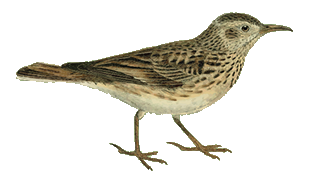State of conservation
The Dupont’s lark (Chersophilus duponti) is one of the scarcest and most endangered birds in Spain and Europe. In Spain, it is listed in the “species in danger of extinction” category of the “Red Book of the vertebrates of Spain” and it is legally designated as “vulnerable” (Spanish catalogue of Endangered Species, R.D. 139/2011).
At the European level, the Dupont’s lark is considered as a species that must be a subject of special prevention measures regarding its habitat, in order to ensure its survival y its reproduction in its distribution zone (Annex I, 79/409/ECC of the birds Directive)
In 2014, it was incorporated in the list of the Ornis Committee and became a priority species to receive funding through the programme LIFE. However, from our present knowledge, so far neither the Dupont’s lark nor its habitat, the rockrose bushes have been the main objective of any LIFE projects.
The Spanish population constitutes the unique presence in the European continent. The latest and most reliable estimates of the population size indicate the existence of approximately 3400-4500 males in Spain. If we consider that the adult sex-ratio is biased towards males (females/males: 0, 61), it has been estimated that the Spanish population is approximately composed of 2200-2800 pairs. This population size is extremely small for a small-sized bird and the negative trend that has been noted in a large part of its distribution area makes it worse.
The Dupont’s lark conservation is being compromised by various factors, the most important being the loss of the habitat quality, either directly with the destruction of the rockrose bushes, or indirectly with the deterioration of the conditions allowing the presence of the species. The habitat loss not only reduces the distribution area but also increases the spatial fragmentation. Locally, the extinction and the reduction of the distribution area and the isolation of the populations are developed by the limited dispersive capacity that seems to characterize the species.
The habitat is important because of the extremely selective behaviour that the Dupont’s lark has. The Dupont’s lark uses a very specific type of steppe habitats, in low bushes on flat grounds. These types of steppe habitats have been traditionally shared between agriculture and livestock. Indeed, there is a close link between the Dupont’s lark and the extensive sheep grazing, since it seems that this livestock use is the origin and the maintenance of the habitat structure. The high specificity of the Dupont’s lark and the selection of means that are subjects to an intense management are critical factors for its conservation. In this regards, the threats to the species are the disappearance of the traditional livestock use, the intensification of farming, reforestations, and infected tree plantations and, recently, the implementation of wind farms.
On the other hand, the specific characteristics of the Dupont’s lark, a small passerine species with an elusive behaviour and a basic biology still not very well known, make it difficult the implementation of direct management measures to improve its state of conservation. Because of that, in this project we are thinking about acting indirectly, through its habitat, by restoring lands that are currently inappropriate and by improving the quality of the habitat that is potentially suitable.
The dispersive capacity, apparently limited, of the species not only requires the increase of the optimal habitat surface, and therefore the increase of the populations’ carrying capacity, but also the connectivity facilitation between populations.
From the point of view of the local social perception, also, the Dupont’s lark is an unknown species that is even considered as an obstacle to development. The majority of the best Iberian populations of the species, according to the proposals for this project, are located in regions that are among the least populated areas of Europe (density
The Dupont’s lark populations, concretely the goal of the project, are the SPAs of “Altos de Barahona” and “Páramo de Layna”. Both SPAs form the most important core of the Spanish population of the Iberian System, and number approximately 15% of the species composition in Spain (i.e. Europa) and more than half of the existing ones in Castile-and-León. One of the objectives of the project is to improve the awareness and the social perception level of the species, and to contribute to the idea that the conservation may be an important tool for the development.

Copyright © 2020 - Aviso Legal | Acceso | Desarrollado por Cesefor





